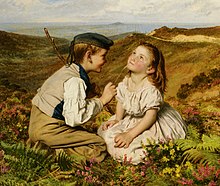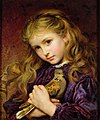
| Sophie Gengembre Anderson | |
|---|---|
| Born | Sophie Gengembre 1823 (1823) Paris, France |
| Died | 10 March 1903(1903-03-10) (aged 79–80) Falmouth, Cornwall, England |
| Resting place | Falmouth Cemetery at Swanvale, Falmouth, England 50°8′46.08″N 5°4′38.73″W / 50.1461333°N 5.0774250°W / 50.1461333; -5.0774250 |
| Nationality | French-born British |
| Education | Charles de Steuben |
| Known for | Painting |
| Notable work |
|
| Spouse | Walter Anderson |
Sophie Gengembre Anderson (1823 – 10 March 1903) was a French-born British Victorian painter who was also active in the United States for extended periods. She specialised in genre paintings of children and women, typically in rural settings. She began her career as a lithographer and painter of portraits, collaborating with Walter Anderson on portraits of American Episcopal bishops. Her work, Elaine, was the first public collection purchase of a woman artist. Her painting No Walk Today was purchased for more than £1 million.
Early life
Anderson was born in Paris, the daughter of Charles Antoine Colomb Gengembre, a French architect and artist, and his English wife, Marianne Farey (1799–1883), a daughter of John Farey Sr. (1766–1826) and his wife Sophia Hubert (1770–1830). They married at St Pancras Church, London, on 12 April 1818.
Her father was born in 1790 and began working as an architect at age 19. He worked primarily in municipal commissions, like the Mint of the City of Cassel, which he designed and built when he was 19. He was injured during the Revolution of 1830 on the same day that his son Philip was born. The family then went to London, where Gengembre worked as an architect for Charles Fourier. He returned to France and continued his work as an architect, designing communal schools around France. The family moved to the United States and adopted the surname Hubert, because of difficulties in people pronouncing their French surname. After moving to Cincinnati, Ohio, he settled in Manchester, Pennsylvania. By 1863, he had designed the Allegheny City Hall "pro bono". He stopped speaking English in protest after he was offered a share of the graft of over-inflated construction costs. The Gengembre family lived in Paris during the early years of Sophie's life, where her father was acquainted with artists, intellectuals and actors, including François Joseph Talma. Circumstances required that the family leave Paris and live in a "remote area in France" from 1829 to 1843. At age 17, she developed an interest in art when a travelling portrait painter visited her town.
She had two brothers, Philip and Henry. Her brother Philip changed his name to Philip Hubert, using his grandmother's maiden name, and was a successful architect in New York City. She was largely self-taught in art, but briefly studied portrait painting with Charles de Steuben in about 1843, when she lived with family friends in Paris. Soon after she began her studies, he left for Russia and did not return within the one year allotted for her studies. She did develop relationships with other women artists at the school where she gained a little more instruction.
United States

The family left France for the United States to escape the 1848 revolution. The family first settled in Cincinnati, Ohio, where she met her future husband, the British genre artist Walter Anderson. Her brother Henry P. Gengembre (b. 1825) was also an artist, active in Cincinnati in the early 1850s.
Her portrait, figure and Brittany landscape paintings were exhibited in October 1849 at the Western Art Union Gallery. Also exhibited was a three panel set of Victorian London scenes entitled The Ladder of Love, which was described as "the lady, in her flowery 'May of Life,' awaits in her father's garden a stolen interview with her lover; in the second, she is seen eagerly caught in his impatient arms, ere he has yet left the ladder upon which he surmounted the garden wall; in the third, having received and given reveals of unfaltering love, she walks alone again – beautiful in the enrobing light of a summer moon, happy in the assurance that the warmth and devotedness of her affection is reciprocated."
In 1851 four or more of her illustrations were included in the Historical Collections of the Great West by Henry Howe. She collaborated with Walter Anderson, her future husband, on portraits of Protestant Episcopal bishops and created other portraits in her business.

She then lived in Manchester, Pennsylvania, with her parents, where she is believed to have married Walter Anderson. She worked there for the chromolithographers Louis Prang & Company.
Europe

In 1854, the Andersons moved to London, where Sophie exhibited a still life of fruit, vegetables, game, and fish entitled An American Market Basket at the Society of British Artists by 1855. It was considered an "admirable composition" made with "surprising truth". Her genre pieces were also exhibited at the Royal Academy. They returned to Pennsylvania in 1858 for a long visit with her family, during which time she exhibited at the Pittsburgh Artist's Association in 1859 and 1860. The latter year she and her husband had work shown at the National Academy of Design. She then settled in London again around 1863.
Anderson's work was widely exhibited at venues including the Royal Academy, the Royal Society of British Artists (RBA), and the British Institution. Her work, Elaine, was one of the first public collection purchases of a living woman artist. The Marquis de Murrieta contributed the painting A Fairy Messenger to a mixed charity exhibition in 1871.
Her oil painting Foundling Girls at Prayer in the Chapel (mid-c19th – late-c19th) is displayed at the Foundling Museum; correlating well with Anderson's typical genre painting of children and women and the museum's focus. The painting depicts the varying ages of the foundling girls, what they wore, and references the religious aspects of their life.
To manage her health issues, the couple moved to the Isle of Capri in 1871, where they lived, painted, and entertained society in a house with a large garden called Villa Castello. Capri was then an artists colony. Its residents included Frederic Leighton, Walter McLaren, John Singer Sargent, Edouard Alexandre Sain, and Jean Benner. She exhibited at the Grosvenor Gallery between 1878 and 1887. Anderson made Italian genre and Neoclassical paintings, including paintings of peasant women and children. At a time when it was difficult for women to have a successful artistic career, these paintings, generally made by men, allowed for her to have a successful career.
Later years and death
The couple moved to England in 1894 and lived and painted in Wood Lane Cottage in Falmouth, Cornwall. She continued to exhibit her work in London. On 11 January 1903 her husband Walter died and two months later, on 10 March 1903, she died at home in Falmouth. She was buried at Swanvale cemetery in Falmouth in the same grave as her husband.
Legacy
A world record price for her work of more than £1 million was achieved by No Walk Today at Sotheby's, London, in November 2008. It made her "Cornwall's first million-pound female artist."
Anderson's work is in the collection of numerous museums and galleries, mainly in the United Kingdom, including Leicester Museum & Art Gallery; Russell-Cotes Art Gallery & Museum, Bournemouth; Royal Botanic Gardens, Kew; Walker Art Gallery, Liverpool; Birmingham City Art Gallery; Museum and Art Gallery, Walsall, Staffordshire; and the Wolverhampton Art Gallery, Staffordshire.
Gallery
-
 The Turtle Dove
The Turtle Dove
-
 No Walk Today
No Walk Today
-
 Capri Girl with Flowers
Capri Girl with Flowers
-
 Wait for Me
Wait for Me
-
 Windfalls
Windfalls
-
 Young Girl Fixing Her Hair
Young Girl Fixing Her Hair
-
 Love in a Mist
Love in a Mist
-
 An Autumn Princess
An Autumn Princess
-
 A Spring Beauty
A Spring Beauty
-
 Her Favorite Pets
Her Favorite Pets
-
 The Children's Story Book
The Children's Story Book
-
 The Head of a Nymph
The Head of a Nymph
-
 Portrait of a Young Girl
Portrait of a Young Girl
See also
References
- Yeldham, Charlotte. "Anderson , Sophia ". Oxford Dictionary of National Biography (online ed.). Oxford University Press. doi:10.1093/ref:odnb/57068. (Subscription or UK public library membership required.)
- "Anderson, Sophie Gengembre". London Atelier of Representational Art. Archived from the original on 6 October 2011.
- ^ Stewart, Brian; Cutten, Mervyn (1997). The Dictionary of Portrait Painters in Britain up to 1920. Antique Collectors' Club. ISBN 1-85149-173-2.
- Woolrich, A.P. (1997). "John Farey, Jr, Engineer and Polymath". History of Technology. 19: 116.
- ^ McCreery, Emilie (July 1931). "The French Architect of the Allegheny City Hall". Western Pennsylvania Historical Magazine. 14 (3): 237–241. Retrieved 22 August 2024.
- ^ Benezit Dictionary of Artists Volume 1 A-Bedeschini. Paris: Editions Grund. 2006. ISBN 2-7000-3070-2.
- ^ Clayton, Ellen Creathorne (1876). English Female Artists. London: Tinsley Brothers. pp. 7–9.
- ^ Haverstock, Mary Sayre; Vance, Jeannette Mahoney; Meggitt, Brian L. (2000). Artists in Ohio, 1787–1900: A Biographical Dictionary. Kent State University Press. p. 329. ISBN 978-0-87338-616-6.
- ^ "Sophie Gengembre Anderson". Cornwall Artists Index. Retrieved 6 March 2014.
- Posner, D. J. (2012). Cerebrations of a Flower Child. Xlibris Corporation. p. 2. ISBN 978-1-4771-6629-1.
- Zaczek, Iain (2005). Angels & fairies. Internet Archive. London : Flame Tree. p. 52. ISBN 978-1-84451-264-5.
- The Forty-Sixth Annual exhibition. London: Royal Society of British Artists. 1869. p. 17. Retrieved 22 August 2024.
- ^ Wood, Christopher (1978). The Dictionary of Victorian Painters. Antique Collectors' Club. ISBN 0-902028-72-3.
- ^ Denney, Colleen (2000). At the temple of art: the Grosvenor Gallery, 1877–1890. Fairleigh Dickinson University Press. p. 130. ISBN 9780838638507.
- Nichols, Kate (20 September 2018). "Victorian women artists in public collections: the case of Sophie Anderson". Art UK.
- The painting was in the 'Exhibition for the Benefit of the Distressed Peasantry of France', London in 1871 (no.55) and priced 15 guineas.
- "What Is A Foundling". Foundling Museum.
- ^ Haverstock, Mary Sayre; Vance, Jeannette Mahoney; Meggitt, Brian L. (2000). Artists in Ohio, 1787–1900: A Biographical Dictionary. Kent State University Press. pp. 18–19. ISBN 978-0-87338-616-6.
- ^ "Sophie Anderson". Falmouth Art Gallery. Retrieved 6 March 2014.
- Money, James (2012). Capri: Island of Pleasure. Faber and Faber. p. 1872. ISBN 978-0-571-29783-2.
- Bailey, Charlotte (4 November 2008). "Sophie Anderson's No Walk Today up for sale". Daily Telegraph. Retrieved 2 July 2013.
- "Gallery buys new Anderson work". The Cornishman. 11 April 2011. Archived from the original on 7 March 2014.
- ^ "Sophie Anderson". Art UK. BBC. Retrieved 7 March 2014.
- ^ Wright, Christopher; Gordon, Catherine May; Smith, Mary Peskett (2006). British and Irish Paintings in Public Collections: An Index of British and Irish Oil Paintings by Artists Born Before 1870 in Public and Institutional Collections in the United Kingdom and Ireland. Yale University Press. p. 67. ISBN 0-300-11730-2.
Further reading
- Gaze, Delia (Ed.). Dictionary of women artists, Volume 1 (Routledge, 1997) pp. 186–187.
- Vigué, Jordi. Great women masters of art (Watson-Guptill Pubs., 2003) p. 197 ff.
External links
- Sophie's Cat Paintings
- Anderson online (ArtCyclopedia)
- Paintings by Anderson (ArtMagick)
- Sophie Gengembre Anderson's artworks
- Sophie Gengembre Anderson's life as an artist
- Sophie Anderson's Roses presented to the Falmouth Art Gallery
- Sophie Anderson's Elaine on display at the Walker Art Gallery
- 1823 births
- 1903 deaths
- 19th-century English painters
- 20th-century English painters
- 20th-century English women artists
- 19th-century English women artists
- Artists from Paris
- English portrait painters
- English women painters
- French people of English descent
- French emigrants to the United Kingdom
- French emigrants to the United States
- 20th-century British women painters
- 19th-century British women painters